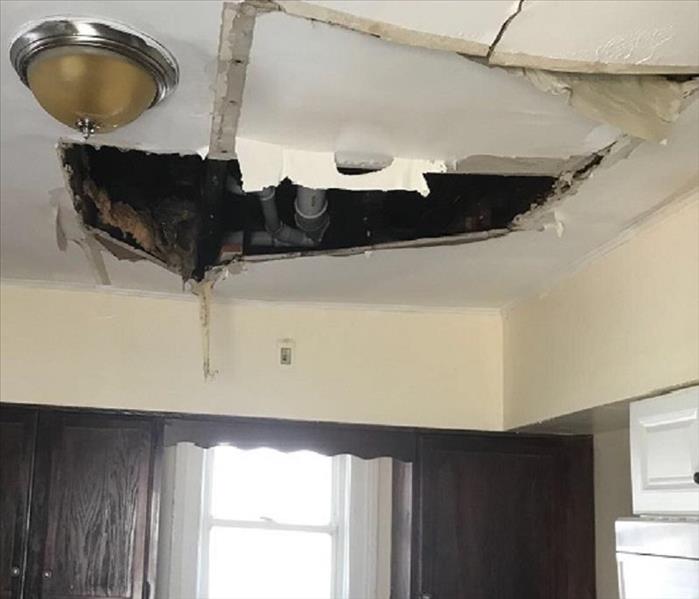Troubleshooting a Mysterious Ceiling Leak in your Saugerties Home
5/11/2020 (Permalink)
 Don't underestimate the weight of water, if you're noticing changes in your ceiling and walls, call a plumber and SERVPRO asap!
Don't underestimate the weight of water, if you're noticing changes in your ceiling and walls, call a plumber and SERVPRO asap!
If you’re starting to notice wet spots, bubbling paint, discoloration, sagging or buckling on your ceiling or at the top of your walls, you’re likely wondering where the moisture could be coming from to get to this point of damage.
Unlike a burst pipe or clear appliance leak, ceiling leaks can be more challenging to figure out and treat as there are many elements that are obscured by your home’s finishes. Here are some handy indicators regarding the two most common types of ceiling leaks:
How to Identify a Roofing System Leak
If you have an attic and you have a leak in the ceiling below it, that may be due to a roofing system issue. In most cases, a roof leak will be due to water getting into a hole or through another compromised area in the roof. Roofing system leaks can generally be identified by:
- Leaking that occurs when it’s raining, heavy snowfall or pops up shortly after a
- Dripping water that is off-colored or murky looking, as it may have picked up debris as it traveled from the You’ll want to have this addressed quickly as this water has contaminants in it from traveling through levels and insulation.
- If the leak is correlated with a buildup of ice along the eaves of your home, it may be due to the ice partially melting and seeping into the This is also known as Ice Damming.
- Attic insulation that is wet, soggy, has a noticeable dirty and musty odor or has evidence of mold and mildew, is a sign that it is absorbing some of the water from the Water-logged insulation gets very heavy and can cause damage if it falls.
- Musty smells or signs of mold around the area above the leak in the Sometimes you might notice a fuzzy, white growth or even mottled black spots near that area. The leak is providing a constant food source to naturally occurring mold spores. Once you remedy the leak, the mold (which must be cleaned first), will stop growing in an unfavorable environment.
How to Identify a Ceiling Leak That Is Due to Plumbing
If a ceiling leak is located in an area where plumbing pipes or fixtures run above it, that may be evidence that you have a plumbing-related problem. This is common in rooms located below bathrooms, kitchens or laundry rooms, which are an indicator that the leak is due to supply pipes or drainpipes located within the ceiling. These can be identified by:
- Dripping water that is clear, if it is from a supply line in the Not to be taken lightly, this water source has some potential to do heavy damage if it goes unnoticed.
- Steady leakage that occurs every time you utilize something that might be routed to the plumbing pipes above, or leakage that occurs slowly but regularly, which could indicate a supply pipe Call a plumber asap, once that issue is resolved, the water damage process can begin.
Regardless of what type of ceiling leak you have, it is always recommended that you begin the restoration process as quickly as possible to mitigate any further damages.
If you have water damage to your ceiling, call us right away to begin the water restoration process and reduce the likelihood of further damages.





 24/7 Emergency Service
24/7 Emergency Service